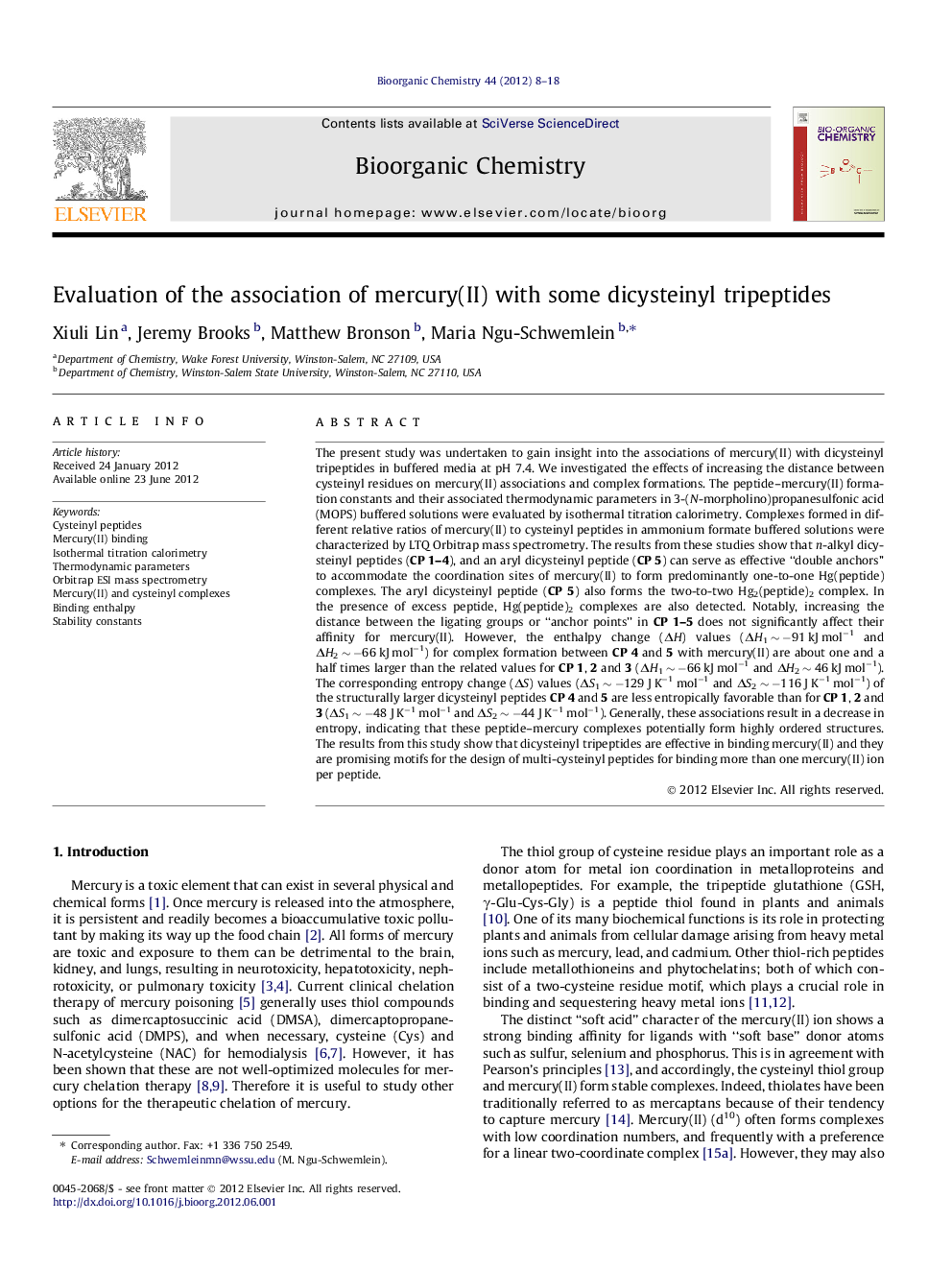| کد مقاله | کد نشریه | سال انتشار | مقاله انگلیسی | نسخه تمام متن |
|---|---|---|---|---|
| 1356326 | 1500470 | 2012 | 11 صفحه PDF | دانلود رایگان |

The present study was undertaken to gain insight into the associations of mercury(II) with dicysteinyl tripeptides in buffered media at pH 7.4. We investigated the effects of increasing the distance between cysteinyl residues on mercury(II) associations and complex formations. The peptide–mercury(II) formation constants and their associated thermodynamic parameters in 3-(N-morpholino)propanesulfonic acid (MOPS) buffered solutions were evaluated by isothermal titration calorimetry. Complexes formed in different relative ratios of mercury(II) to cysteinyl peptides in ammonium formate buffered solutions were characterized by LTQ Orbitrap mass spectrometry. The results from these studies show that n-alkyl dicysteinyl peptides (CP 1–4), and an aryl dicysteinyl peptide (CP 5) can serve as effective “double anchors” to accommodate the coordination sites of mercury(II) to form predominantly one-to-one Hg(peptide) complexes. The aryl dicysteinyl peptide (CP 5) also forms the two-to-two Hg2(peptide)2 complex. In the presence of excess peptide, Hg(peptide)2 complexes are also detected. Notably, increasing the distance between the ligating groups or “anchor points” in CP 1–5 does not significantly affect their affinity for mercury(II). However, the enthalpy change (ΔH) values (ΔH1 ∼ −91 kJ mol−1 and ΔH2 ∼ −66 kJ mol−1) for complex formation between CP 4 and 5 with mercury(II) are about one and a half times larger than the related values for CP 1, 2 and 3 (ΔH1 ∼ −66 kJ mol−1 and ΔH2 ∼ 46 kJ mol−1). The corresponding entropy change (ΔS) values (ΔS1 ∼ −129 J K−1 mol−1 and ΔS2 ∼ −116 J K−1 mol−1) of the structurally larger dicysteinyl peptides CP 4 and 5 are less entropically favorable than for CP 1, 2 and 3 (ΔS1 ∼ −48 J K−1 mol−1 and ΔS2 ∼ −44 J K−1 mol−1). Generally, these associations result in a decrease in entropy, indicating that these peptide–mercury complexes potentially form highly ordered structures. The results from this study show that dicysteinyl tripeptides are effective in binding mercury(II) and they are promising motifs for the design of multi-cysteinyl peptides for binding more than one mercury(II) ion per peptide.
Figure optionsDownload as PowerPoint slideHighlights
► n-Alkyl- and aryl-dicysteinyl tripeptides (CP 1–5) binds Hg(II) very effectively.
► Increase in distance between the cysteinyl residues does not significantly affect affinity.
► They form predominantly Hg(CP)2 and Hg(CP) complexes.
► The aryl dicysteinyl peptide (CP 5) also forms a Hg2(CP 5)2 complex.
Journal: Bioorganic Chemistry - Volume 44, October 2012, Pages 8–18